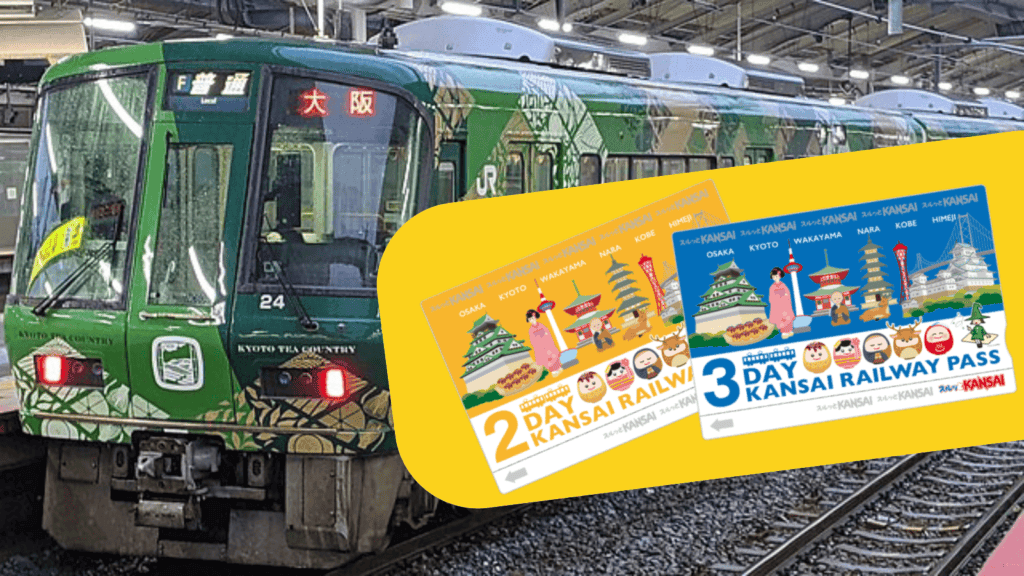When planning a trip to the Kansai region of Japan, selecting the right transportation pass can significantly enhance your travel experience by saving both time and money. Among the various options available, two popular choices are the Kansai Area Pass and the Kansai Railway Pass. Each of these passes offers distinct advantages tailored to different travel styles and needs.
In this comprehensive guide, we will get into the details of both passes, exploring their features, coverage areas, benefits, and considerations to help you make an informed decision for your journey through one of Japan’s culturally rich and historically significant regions.
Introduction to the Kansai Region
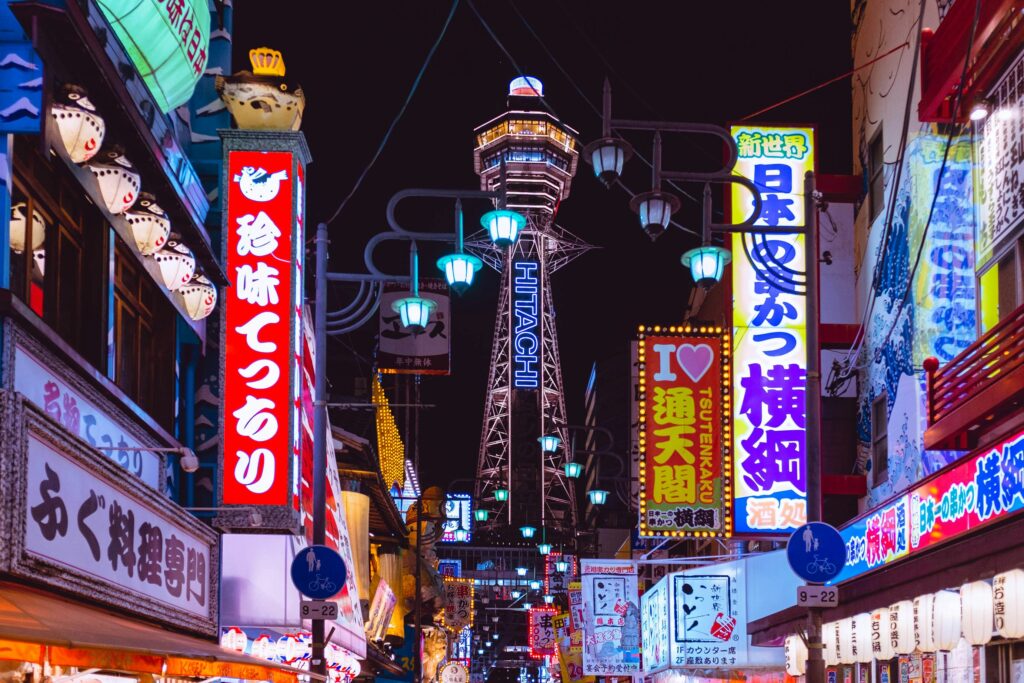
The Kansai region, located in the southern-central part of Japan’s main island of Honshu, is known for its historical landmarks and vibrant cities. Major cities in the Kansai region include Osaka, Kyoto, Nara, and Kobe, each offering its own unique charm and attractions.
Travellers often flock to Kansai to explore ancient temples, traditional tea houses, bustling markets, and modern entertainment districts, making it a diverse and fascinating destination for tourists from around the world.
Understanding Transportation Needs in Kansai
Navigating the Kansai region efficiently requires careful consideration of transportation options. While public transportation in Japan is famously punctual and extensive, having a regional pass can streamline your travel plans and offer substantial savings, especially for tourists planning to visit multiple destinations within a short period.
Overview of the Kansai Area Pass
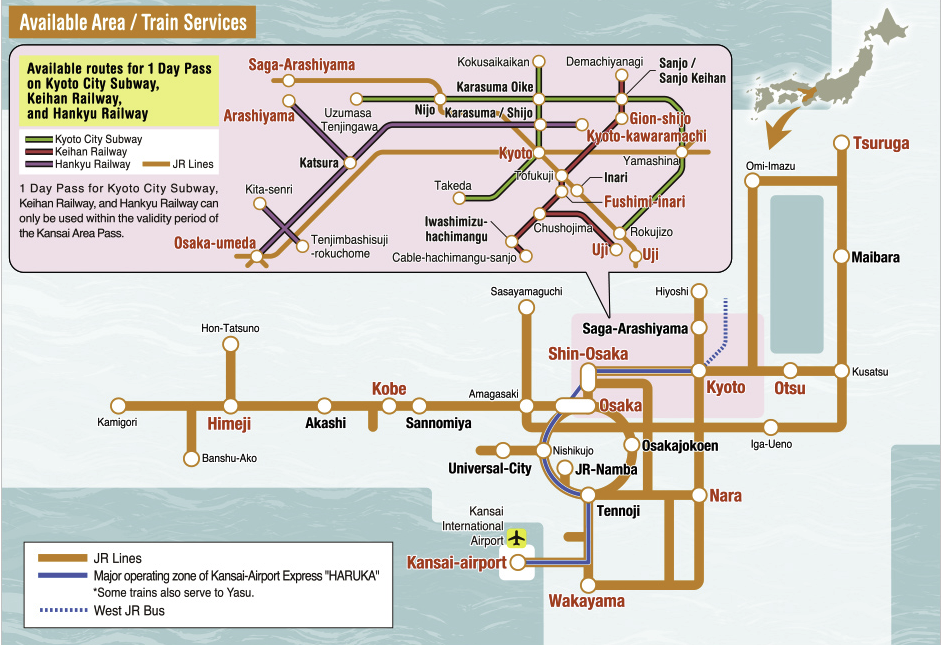
What is the Kansai Area Pass?
The Kansai Area Pass is a rail pass offered by JR West, specifically designed for tourists exploring the Kansai region. This pass allows for unlimited travel on JR West lines within the designated area, which includes cities like Osaka, Kyoto, Nara, and Kobe. It is ideal for travellers planning to extensively explore these cities and their surrounding areas using JR trains.
Key Features of the Kansai Area Pass
Unlimited JR Train Travel
The pass covers all JR West local, rapid, and special rapid services within the Kansai region. This includes:
- Local Trains: For short distances within cities.
- Rapid Services: Faster connections between major cities.
- Special Rapid Services: The fastest JR trains in the region, stopping at fewer stations.
Validity Options
The Kansai Area Pass offers flexible validity options to match different travel itineraries. You can choose from:
- 1-Day Pass: ¥2,400 for adults, ¥1,200 for children
- 2-Day Pass: ¥4,600 for adults, ¥2,300 for children
- 3-Day Pass: ¥5,600 for adults, ¥2,800 for children
- 4-Day Pass: ¥6,800 for adults, ¥3,400 for children
Airport Transfers
The pass includes travel from Kansai International Airport to major cities within the region, making it convenient for international travellers. This includes:
- Direct service to Osaka, Kyoto, and other major cities via the Haruka Express.
Benefits of Choosing the Kansai Area Pass
- Convenience: With unlimited travel on JR lines, you have access to major stations and tourist destinations without the need to purchase individual tickets.
- Cost-Effectiveness: For travellers planning to use JR trains extensively, the pass offers significant cost savings compared to buying single tickets for each journey.
- Ease of Use: The pass can be purchased in advance and activated upon arrival, providing a seamless travel experience right from Kansai International Airport or major train stations in the region.
Overview of the Kansai Railway Pass
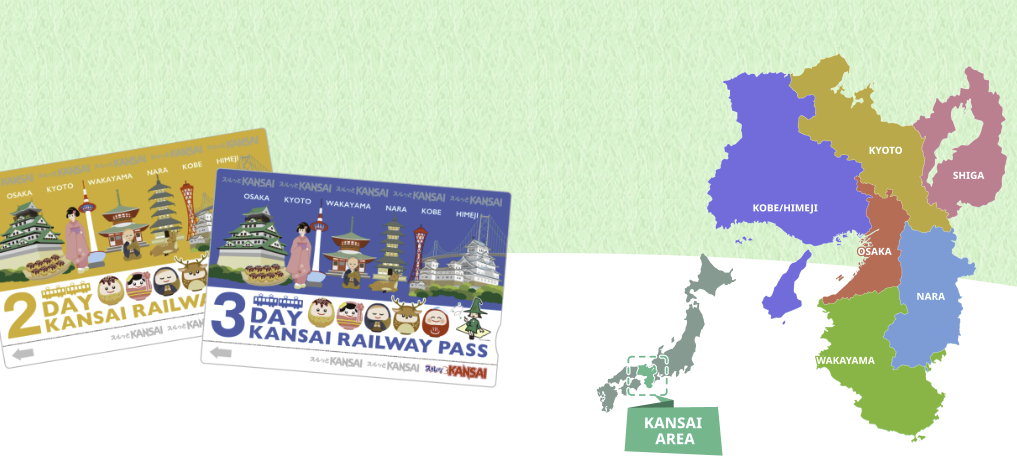
What is the Kansai Railway Pass?
The Kansai Railway Pass, previously known as the Kansai Thru Pass, is a rail pass specifically tailored for tourists exploring the Kansai region. This pass grants unlimited travel on various private railways and subway systems throughout Osaka, Kyoto, Kobe, and Nara, excluding JR lines. It’s designed for travellers looking to extensively explore the region’s cities and their surrounding areas using a broad network of non-JR trains.
Key Features of the Kansai Railway Pass
Unlimited Travel on Non-JR Trains
The Kansai Railway Pass offers comprehensive access to a wide array of transportation networks across the Kansai region, enhancing travel flexibility and convenience. Here’s a more detailed look at the networks covered:
Private Railways
The pass includes unlimited access to several major private railway lines, each serving key parts of the Kansai region:
- Hankyu Railway: Connects Osaka with Kyoto and Kobe, offering a scenic route that includes stops in culturally rich areas such as Arashiyama in Kyoto and the fashionable areas of Umeda in Osaka and Sannomiya in Kobe.
- Hanshin Railway: Provides direct connections between Osaka and Kobe, including stops in the famous Nada district, known for its sake breweries.
- Kintetsu Railway: The largest private railway in Japan, covering extensive routes that connect Nara, Kyoto, Osaka, and Ise-Shima. It is essential for tourists visiting classic historical sites like the Ise Grand Shrine and Nara Park.
- Nankai Railway: Primarily operates in Osaka Prefecture and offers direct routes to Kansai International Airport and Wakayama, including access to spiritual sites like Mount Koya.
Subways
- Osaka Metro: Covers numerous lines that traverse the city, linking key districts such as Namba, Umeda, and Tennoji. It is ideal for exploring urban attractions like the Osaka Aquarium and the bustling shopping districts.
- Kyoto Municipal Subway: Though smaller, it provides critical links to major zones in Kyoto, including the downtown area and the northern precincts near the Kyoto Imperial Palace and Kitayama.
Validity Options
The Kansai Railway Pass offers flexible validity options to suit different travel plans:
- 2-Day Pass: ¥5,600 for adults, ¥2,800 for children
- 3-Day Pass: ¥7,000 for adults, ¥3,500 for children These days can be used non-consecutively within a specified validity period, offering flexibility to travellers who may want breaks between their travel days.
Airport Transfers
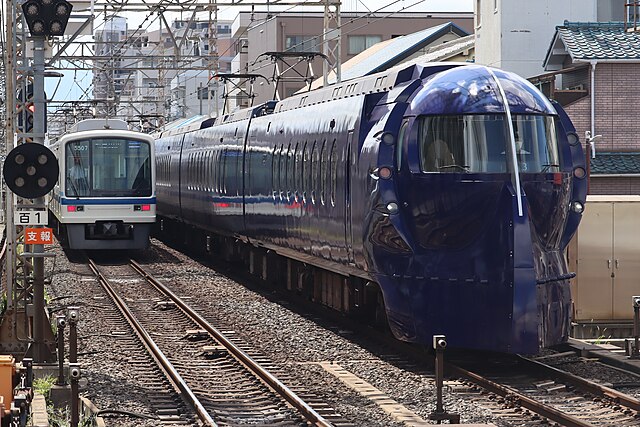
While the Kansai Railway Pass does not cover JR lines, it effectively facilitates connections from Kansai International Airport to various key destinations using alternative services. Here’s a detailed overview of how you can utilise the pass for airport transfers:
- Nankai Railway: The Nankai Railway is one of the primary services supported by the Kansai Railway Pass for transfers from Kansai International Airport. It offers an efficient route directly into the heart of Osaka. Here’s how you can make the most of it:
- Nankai Airport Express: This service connects the airport to Namba Station, one of Osaka’s main hubs, offering a convenient and economical option for travelers. The journey takes approximately 45 minutes, making it a quick way to reach downtown Osaka.
- Rapi:t Service: For a faster, more premium experience, the Rapi:t express train reduces travel time to just under 40 minutes to Namba. Note that while the Kansai Railway Pass covers the basic fare, a seat reservation and express surcharge are required for the Rapi:t service.
- Connecting Services: Once at Namba Station, you can continue your journey using other railways included in the Kansai Railway Pass:
- Hankyu and Hanshin Railways: These lines can be accessed by a short transfer from Namba, allowing you to reach other major destinations like Kobe and Kyoto. Transfers are generally straightforward and these lines provide extensive coverage within the Kansai region.
- Osaka Metro: From Namba, you also have access to the extensive Osaka Metro network, which can take you to various parts of Osaka city, including major tourist attractions and business districts.
Benefits of Choosing the Kansai Railway Pass
- Convenience: Offers seamless travel across a wide network of rail systems without the need for separate tickets.
- Cost-Effectiveness: Provides significant savings for travellers planning to use non-JR transport systems extensively.
- Ease of Use: Can be purchased in advance and activated upon arrival, simplifying the travel experience from the moment of landing at Kansai International Airport or other major transit hubs in the region.
Key Differences Between Kansai Area Pass and Kansai Railway Pass
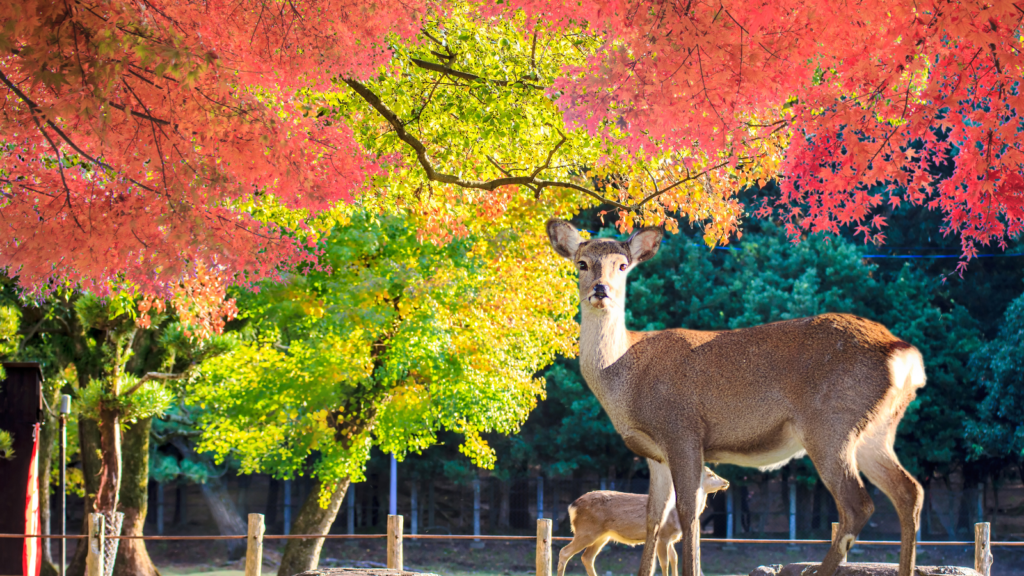
When exploring the Kansai region of Japan, travellers have the option to choose between two distinct transportation passes: the Kansai Area Pass and the Kansai Railway Pass. Each pass offers unique features tailored to different travel needs and preferences. Here are the key differences:
Coverage and Network
- Kansai Area Pass: This pass is exclusively for travel on JR West trains, covering major JR lines within the Kansai region. It is ideal for travellers who plan to visit major cities like Osaka, Kyoto, Nara, and Kobe, which are well-connected by JR trains.
- Kansai Railway Pass: Formerly known as the Kansai Thru Pass, this pass allows unlimited travel on a variety of non-JR transportation networks including private railways, subways, and some cable cars throughout the Kansai region. It caters to those who wish to explore beyond the JR network, offering access to a broader array of destinations.
Flexibility of Use
- Kansai Area Pass: Requires consecutive day use once activated, making it suitable for travellers with a packed itinerary who will be travelling daily.
- Kansai Railway Pass: Offers more flexibility with the option to use the pass on non-consecutive days within a certain validity period. This feature is particularly beneficial for travellers who prefer a more relaxed pace or plan to intersperse travel days with rest days.
Airport Transfer Options
- Kansai Area Pass: Includes convenient airport transfer options, providing direct services to major cities from Kansai International Airport via the JR Haruka Express, which can be a significant advantage for international travellers starting their journey directly from the airport.
- Kansai Railway Pass: Does not include JR services but supports access from Kansai International Airport using other services like the Nankai Railway. This may require travellers to navigate different transfer options depending on their destination.
Cost-Effectiveness
- Kansai Area Pass: Offers great value for travellers planning extensive travel across the JR network, with significant savings on long-distance JR train rides between major cities.
- Kansai Railway Pass: While it may not include JR lines, it compensates with comprehensive coverage of other major and minor rail networks, which can be cost-effective for visits to areas not serviced by JR or for exploring less frequented destinations.
Target User
- Kansai Area Pass: Best suited for tourists who need straightforward and efficient travel across major urban centres connected by JR trains, and who value the ease of having a single pass for all JR travel.
- Kansai Railway Pass: Ideal for more adventurous travellers who want the flexibility to explore a wide range of destinations across the region and those interested in utilising various modes of transport including private railways and subways.
Which Pass Should You Choose?

Deciding between the Kansai Area Pass and the Kansai Railway Pass depends on your specific travel plans, the regions you intend to explore, and your preferred mode of transportation. Here are some considerations to help you choose the pass that best suits your needs:
Consider Your Itinerary
Choose the Kansai Area Pass pass if your travel itinerary is focused on major cities like Osaka, Kyoto, Nara, and Kobe, which are well-connected by JR lines. This pass is ideal if you plan to travel extensively across these cities using JR trains, as it offers unlimited travel on JR West lines and is convenient for rapid city-to-city connections.
Opt for the Kansai Railway Pass if your travel plans include exploring a broader range of areas within the Kansai region, especially those not serviced by JR trains. This pass is beneficial if you want to visit destinations accessible by private railways, subways, and cable cars, such as the mountainous regions or certain cultural sites that are off the main tourist path.
Evaluate Flexibility Needs: Consecutive vs. Non-Consecutive Days
If your trip schedule includes continuous travel days, the Kansai Area Pass is a straightforward choice. However, if you prefer having the flexibility to choose travel days as you go, perhaps with rest days in between, the Kansai Railway Pass’s non-consecutive day feature will be more suitable.
Assess Transportation Coverage
If direct transfers from Kansai International Airport to major cities are a priority, the Kansai Area Pass provides a seamless connection via the JR Haruka Express. For those using other entry points or comfortable with transferring between lines, the Kansai Railway Pass still offers excellent connectivity through other railways like Nankai.
Compare Cost Efficiency
Calculate the potential travel costs without a pass based on your planned routes. The Kansai Area Pass might offer better value if you’re planning multiple long-distance trips between cities on consecutive days. On the other hand, if your travels are more spread out or include many local trips on non-JR lines, the Kansai Railway Pass might be more economical.
Additional Benefits
Both passes offer benefits beyond just travel. Consider which pass offers more advantages for the attractions you plan to visit. The Kansai Railway Pass often includes discounts at various tourist attractions and venues, which can add value to your purchase if these align with your sightseeing goals.
Explore More with the Right Pass

Choosing between the Kansai Area Pass and the Kansai Railway Pass allows you to tailor your travel experience to meet your specific interests and preferences.
With the right pass in hand, you can embark on a journey that immerses you in the heart of this dynamic region, where tradition meets modernity and every turn reveals something new to discover. The choice of pass not only offers convenience and cost-effectiveness but also enriches your exploration, enabling you to access a wide array of attractions seamlessly.
To make the most of your trip, consider enhancing your travel plans with our personalised tour services. Whether you’re looking to learn more about the historic cities of Kyoto and Nara or seeking out the bustling nightlife of Osaka, our expert guides are ready to lead you on an unforgettable adventure tailored just for you.
Visit our website at Flip Japan Guide and book any of our tours today to unlock the full potential of your Kansai experience.
When planning your travels with transportation passes like the Kansai Area Pass or Kansai Railway Pass, accuracy and up-to-date information can make all the difference. While this guide provides a comprehensive overview, the specifics such as prices and validity options are subject to change. Therefore, it’s always a good idea to verify the latest prices and options directly on official websites or reliable travel platforms before making a purchase.

